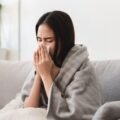Tired in Autumn?

The leaves glow in the most beautiful colors, the air is crisp and fresh – autumn could be so wonderful. If it weren’t for that heavy autumn fatigue that settles over your daily life like a thick blanket, draining every spark of energy. This sudden lack of energy is a widespread phenomenon. But: you don’t have to surrender to this seasonal exhaustion. We’ll show you how to regain control, leave autumn fatigue behind, and enjoy the “golden season” to the fullest.
Why Do We Feel Constantly Tired in Autumn?
The fatigue you feel in autumn isn’t your imagination—it’s a logical reaction of your body. Several scientifically proven factors play an important role:
- Less Light = More Melatonin
When it gets darker outside, your body switches into rest mode. The reason: shorter days stimulate the production of melatonin – the hormone that regulates your sleep. At the same time, serotonin production decreases, the hormone that normally keeps you awake and motivated. This hormonal mix slows down your inner drive – the result: autumn fatigue.
- Inner Clock in Turmoil
The changing light conditions make you tired – autumn throws your circadian rhythm off balance, that is, the biological clock of your body. This affects sleep, digestion, mood, and energy. People who already struggle with fluctuating daylight – such as shift workers or those with heavy screen exposure – are especially sensitive to these changes.
- Vitamin D Deficiency as an Energy Thief
Less sunlight means your body produces less vitamin D. Studies show that low vitamin D levels are linked to fatigue, low mood, and concentration problems. A light therapy lamp can help you compensate for this deficiency – especially on gray days or when working indoors without daylight.
- Heating Air = Stress for Circulation and Mucous Membranes
Indoors it’s warm, outdoors it’s cold – this temperature fluctuation puts stress on your circulatory system. Heating air also dries out the mucous membranes, increasing susceptibility to infections. A humidifier helps maintain balanced humidity. Ideally, this should be between 40–60 % – you can easily check this with a smart hygrometer.
🧠 Additional Knowledge: Psychophysiological Stress in the Ayurvedic Context
In Ayurvedic teaching, the typical autumn fatigue is assigned to the Vata dosha – an energetic principle associated with movement, wind, and dryness. When Vata is out of balance, it can lead to restlessness, sleep disturbances, and energy loss. Western medicine would describe this as “stress reactions” – physiologically, it often manifests as nervous exhaustion.
Symptoms: Melancholy and Fatigue in Autumn
Do you just feel a bit sluggish, or is there more behind it? The symptoms of autumn fatigue can show up in different ways – physically and emotionally. You might recognize some of these common signs in yourself:
- Increased need for sleep: You feel like you could sleep all day but still wake up tired?
- Lack of motivation: Everyday tasks suddenly feel like climbing a mountain?
- Low mood: A general sense of melancholy and irritability creeps in?
- Cravings: Your body craves carbohydrates to get a quick but short-lived energy boost?
This seasonal mood drop differs from an actual Seasonal Affective Disorder (SAD). With SAD, symptoms like hopelessness, depressive moods, and social withdrawal are much stronger. If your extreme fatigue in autumn lasts for weeks, it’s advisable to see a doctor to rule out other causes such as iron deficiency, hypothyroidism, or real depression.
💡 By the way: Some psychologists refer to this as “End of Summer Sadness,” a mild low mood during the transition into autumn. It’s triggered by reduced light exposure, fewer social activities, and the feeling of saying goodbye to summer – completely normal, but good to know.
What Helps Against Autumn Fatigue? Your 5-Step Plan Against the Autumn Blues
If you feel like going into early hibernation, it’s time for a gentle counteraction. The RESET model helps you overcome autumn fatigue and recharge your internal batteries – with simple methods you can easily integrate into your daily life. No stress, no pressure – just a little more structure, light, movement, and warmth. Let’s go!
| RESET Factor | What You Can Do | Why It Helps (Medically & Psychologically) |
| R for Routine | Set fixed sleeping times, even on weekends, and establish regular meal times | Stabilizes your biorhythm and balances melatonin and cortisol levels |
| E for Energy Recharge | Integrate light physical activity such as walking, yoga, or stretching | Exercise releases endorphins – the best remedy against sluggishness and low moods |
| S for Sunlight | Get at least 30 minutes of daylight daily or use a light therapy lamp | Light reduces melatonin and boosts serotonin – for more alertness and a better mood |
| E for Relaxation | Incorporate aromatherapy, breathing exercises, or short breaks with music and massage | Reduces stress hormone cortisol, prevents mental exhaustion, and supports recovery |
| T for Temperature | Plan warmth from inside and outside with heating blankets, bubble baths, or warm drinks | Warmth relaxes muscles, promotes circulation, and provides comfort – an effective anti-fatigue booster |
Your diet can also help stabilize your energy levels. A study by the University of Lübeck shows that late, heavy meals disrupt your rhythm – your body has to work at night instead of regenerating. A breakfast rich in complex carbohydrates and proteins, on the other hand, acts as a biological wake-up signal. Whole-grain bread with cottage cheese, oatmeal with nuts, or a warm egg breakfast? All better than an empty stomach or a quick croissant “to go.”
Why Light Therapy Really Makes Sense Against Autumn Fatigue
Yes, we’ve already talked about light – but this point is too important not to emphasize again. One of the main causes of autumn fatigue is the significant drop in natural daylight. Fewer hours of sunshine mean your internal clock loses sync. Melatonin (the sleep hormone) production increases, while serotonin (the happiness hormone) decreases – the perfect recipe for sluggishness and constant yawning.
According to chronobiology, light is one of the strongest external cues for your biological rhythm, and just 30 minutes of light at 2,500 lux is enough to wake your body from sleep mode.
The solution? The LT 460 daylight lamp by medisana is our favorite for dark days – especially if you work in an office, from home, or simply don’t get outside often enough. With its intense, evenly distributed brightness, it simulates real daylight and produces up to 10,000 lux – without UV rays or flickering. You get a clear, steady light field that gently switches your body to “awake.” And it’s barely bigger than a tablet – perfect for the breakfast table, desk, or handbag.
Comparison Reference:
| Light Source | Brightness (Lux) |
| Normal indoor lighting | approx. 300–500 Lux |
| Overcast autumn sky | approx. 3,500–20,000 Lux |
| Medisana LT 460 daylight lamp | up to 10,000 Lux (constant) |
Staying Energized Despite Autumn Fatigue: Movement and Self-Care for Your Energy
Even if it takes effort: movement such as walking, yoga, or cycling stimulates circulation and releases endorphins, which act as natural mood boosters. Also, incorporate moments of relaxation into your day. Short breathing exercises can reduce stress, and using an aroma diffuser with invigorating scents can help improve concentration at the same time.
Most importantly: accept that your body needs more rest in autumn. Consciously schedule time for yourself – perhaps with a good book, wrapped in a cozy heating blanket, and a cup of tea. These mindful pauses are not a luxury but pure self-care – especially when autumn fatigue strikes. So, make autumn your season of energy – with small rituals that do you good and make a big difference.
Sources:
- Olbrich Hemer – Chronobiologie
Olbrich Hemer: Chronobiologie – Chronotherapie / Lichttherapie. Online veröffentlicht am 22. Februar 2020.
Verfügbar unter: https://www.olbrich-hemer.de/allgemein/chronobiologie.html
- Stiftung Deutsche Depressionshilfe – Weitere antidepressive Behandlungen
Stiftung Deutsche Depressionshilfe: Weitere antidepressive Behandlungen.
Verfügbar unter: https://www.deutsche-depressionshilfe.de/depression-infos-und-hilfe/behandlung/weitere-antidepressive-behandlungen




